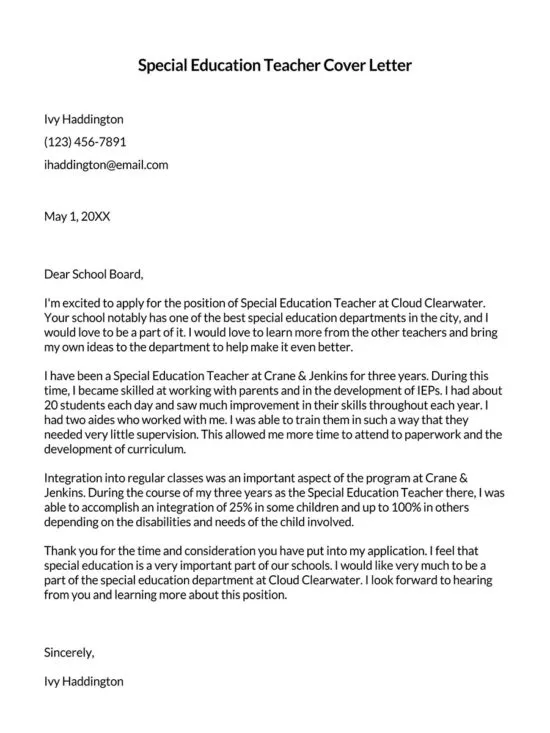Crafting a Winning Teaching Cover Letter
Your teaching cover letter is your first opportunity to make a strong impression on a potential employer. It’s more than just a formality; it’s a critical marketing tool that showcases your qualifications, passion, and suitability for the role. A well-crafted cover letter can significantly increase your chances of securing an interview. It allows you to go beyond your resume and explain why you are the perfect fit for the school and the specific teaching position. This guide will walk you through the key elements of a compelling teaching cover letter, providing practical tips and advice to help you stand out from the competition.
Understanding the Purpose of a Teaching Cover Letter
The primary purpose of a teaching cover letter is to introduce yourself to the hiring committee and highlight your key strengths and qualifications. It should articulate your enthusiasm for the position and the school. The cover letter provides a platform to connect your skills and experiences directly to the job description and the school’s specific needs. It’s a chance to demonstrate your writing skills, communication abilities, and your understanding of the educational landscape. A strong cover letter demonstrates your ability to communicate effectively and professionally, qualities essential for a successful teacher. Moreover, it allows you to explain any career transitions, address gaps in your experience, or provide context for your resume entries.
Highlighting Your Qualifications
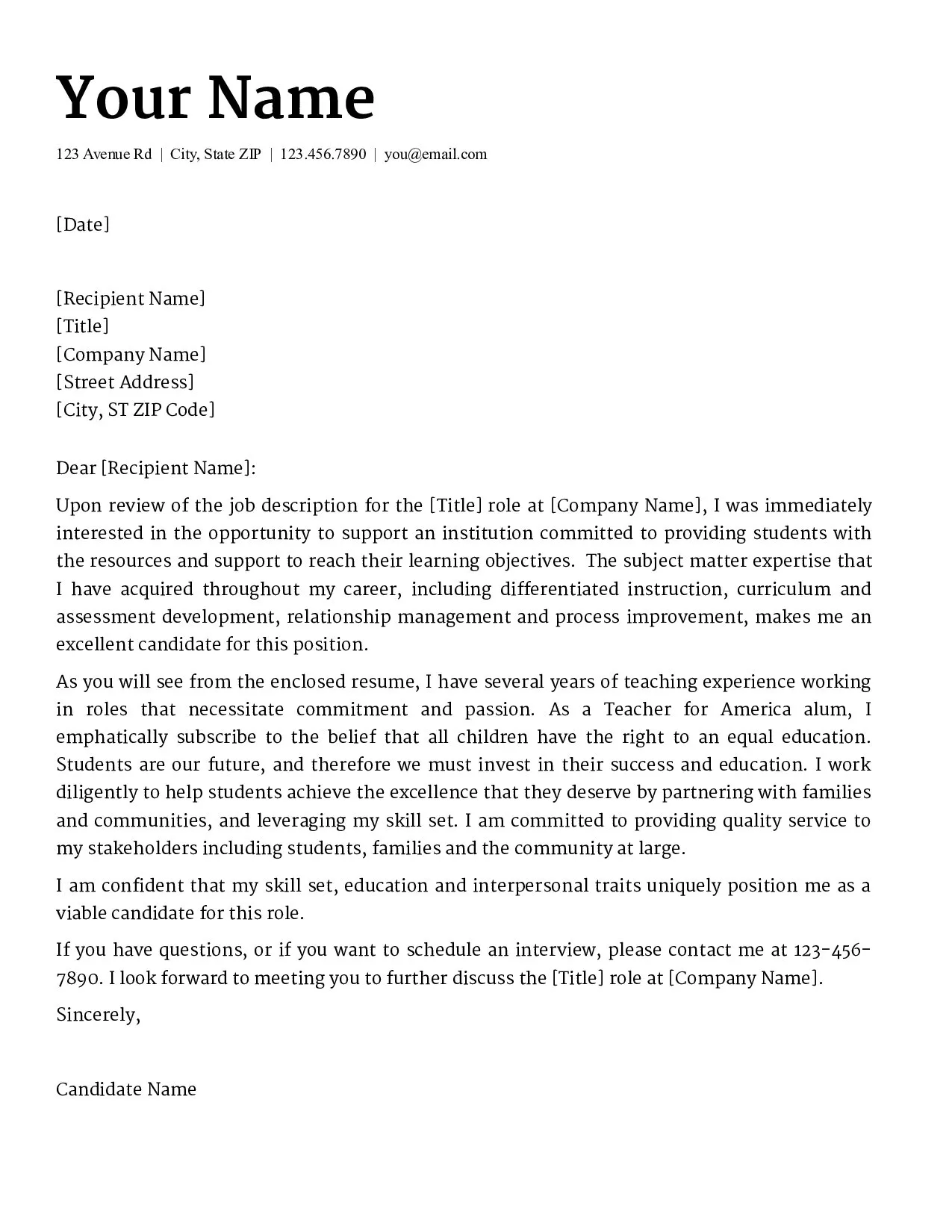
This is the core of your cover letter, where you showcase your credentials and how they align with the job requirements. Be specific and provide concrete examples to support your claims. Avoid vague statements and focus on quantifiable achievements whenever possible. Use action verbs to describe your accomplishments and tailor your examples to match the specific needs outlined in the job posting. The goal is to paint a clear picture of your capabilities and demonstrate your ability to make a positive impact on students and the school community. Remember to keep your target audience in mind the hiring manager. This section needs to highlight your key skills.
Education and Certifications
Start by listing your degrees, certifications, and any relevant coursework. Include the name of the institution, the dates of attendance, and the degree conferred. If you have specialized certifications or endorsements (e.g., special education, ESL), be sure to highlight them, as they can significantly increase your appeal to certain schools. Mention any honors, awards, or scholarships you received. This section should clearly and concisely present your academic background and demonstrate that you meet the minimum requirements for the position. Ensure that you match the information with that listed on your resume. This gives consistency.
Teaching Experience
Describe your teaching experience, including the grade levels, subjects taught, and the schools or districts where you worked. Detail your specific responsibilities, such as lesson planning, curriculum development, student assessment, and parent communication. Quantify your accomplishments whenever possible. For instance, you could mention the percentage increase in student test scores or the number of students who successfully completed a project. Explain how you’ve adapted your teaching methods to meet the diverse needs of students, and share any successful projects or initiatives you led. If you are a recent graduate or have limited experience, focus on student teaching, volunteer work, or any relevant experiences that demonstrate your skills and commitment to education.
Skills and Expertise
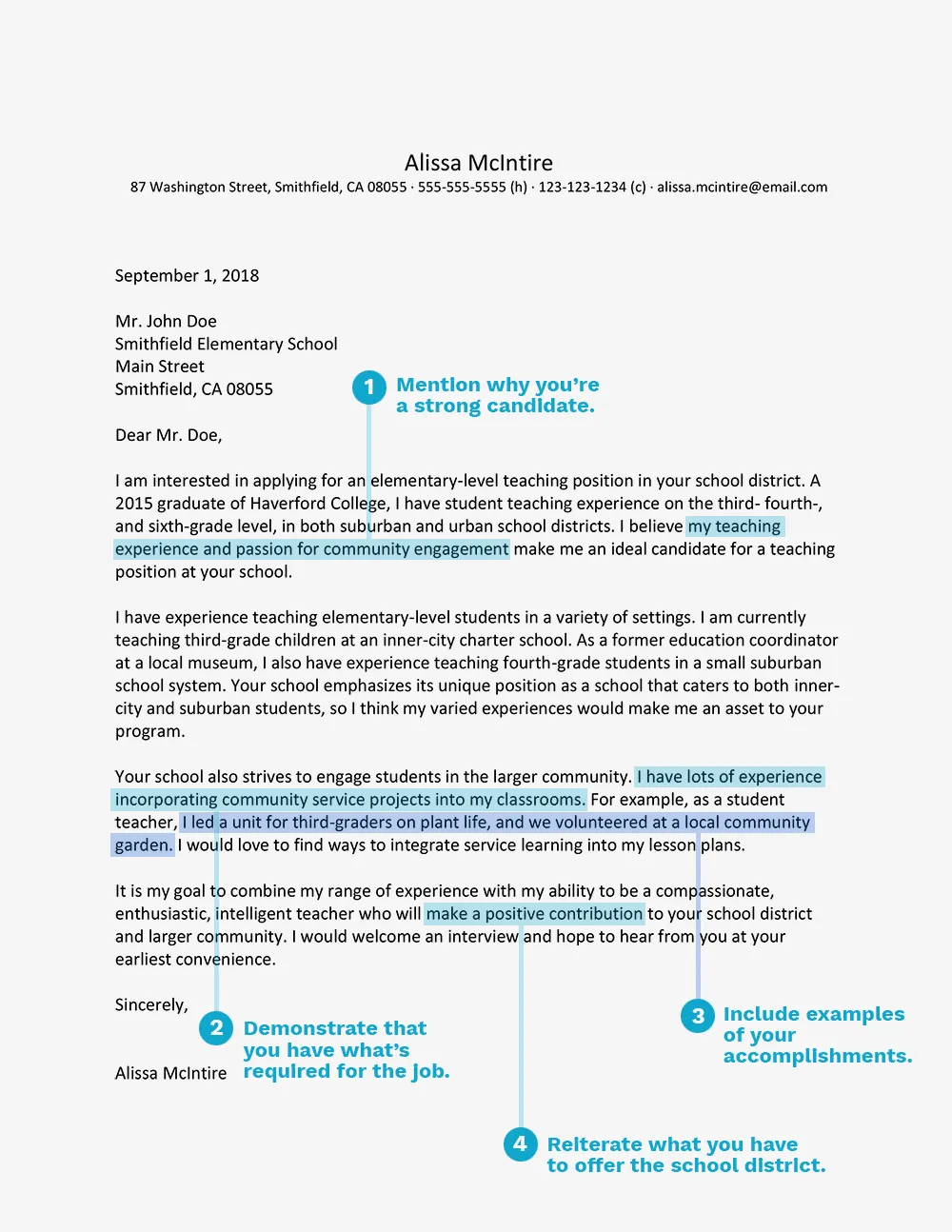
Highlight your key skills and expertise, such as classroom management, differentiated instruction, assessment strategies, and technology integration. Provide concrete examples of how you have used these skills in the classroom to improve student learning and create a positive learning environment. Mention any specialized training you’ve received in areas like special education, literacy, or STEM. If you’re proficient in any languages other than English, be sure to mention them, as it could be a valuable asset. Show your teaching abilities. Also, mention your use of tools and software related to teaching such as Google Classroom, Canva etc.
Showcasing Your Passion for Teaching
This section allows you to convey your genuine enthusiasm for teaching and your dedication to student success. Show the hiring committee why you chose this profession and what motivates you to come to work every day. Your passion is infectious and makes a great first impression on your reader, that can take you a long way. Your enthusiasm should translate to your students. It is what will make them excited to learn and you, a successful teacher. This is key to making your letter stand out.
Enthusiasm for Education
Express your genuine enthusiasm for education. Explain what motivates you as an educator. What aspects of teaching do you find most rewarding? Share your beliefs about teaching and learning. Discuss your commitment to creating a positive and engaging learning environment where all students can thrive. Demonstrate that you understand the importance of continuous professional development and are always seeking ways to improve your teaching practices. Mention any specific educational philosophies or approaches that resonate with you. If the school’s mission aligns with your beliefs, be sure to mention that as well.
Classroom Management Skills
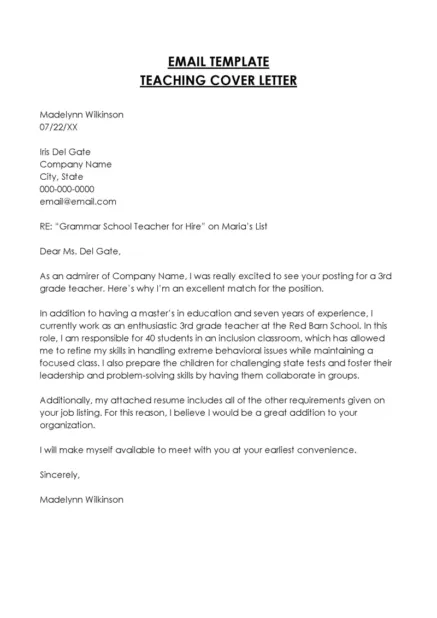
Describe your classroom management skills and how you create a structured and supportive learning environment. Share specific strategies you use to establish clear expectations, manage student behavior, and promote a positive classroom culture. Mention any experience you have with restorative justice practices, positive behavior interventions, or other techniques. Provide examples of how you have successfully handled challenging situations and promoted student responsibility and accountability. Show you understand what a successful classroom looks like and how you contribute to the learning environment. Your approach can be the difference between a smooth-running class and one that’s chaotic.
Creating a Positive Learning Environment
Highlight your ability to create a positive, inclusive, and engaging learning environment. Discuss how you differentiate instruction to meet the diverse needs of all students. Mention your experience with incorporating technology, hands-on activities, and other strategies to make learning fun and relevant. Explain how you foster a sense of community in your classroom and build positive relationships with students, parents, and colleagues. Describe how you encourage student collaboration, critical thinking, and creativity. Your teaching skills must include the ability to create a friendly and stimulating learning environment. Your passion for the job will show in this section.
Tailoring Your Letter to the School
Personalizing your cover letter to each school you apply to is essential. This demonstrates that you have taken the time to research the school and are genuinely interested in the specific position. Generic cover letters that are simply recycled and sent to multiple schools are easily spotted and often discarded. Your cover letter should demonstrate a strong understanding of the school’s culture, values, and mission. Tailoring the letter allows you to demonstrate your suitability to the school. You must be able to adjust to the needs of your reader.
Researching the School’s Values and Mission
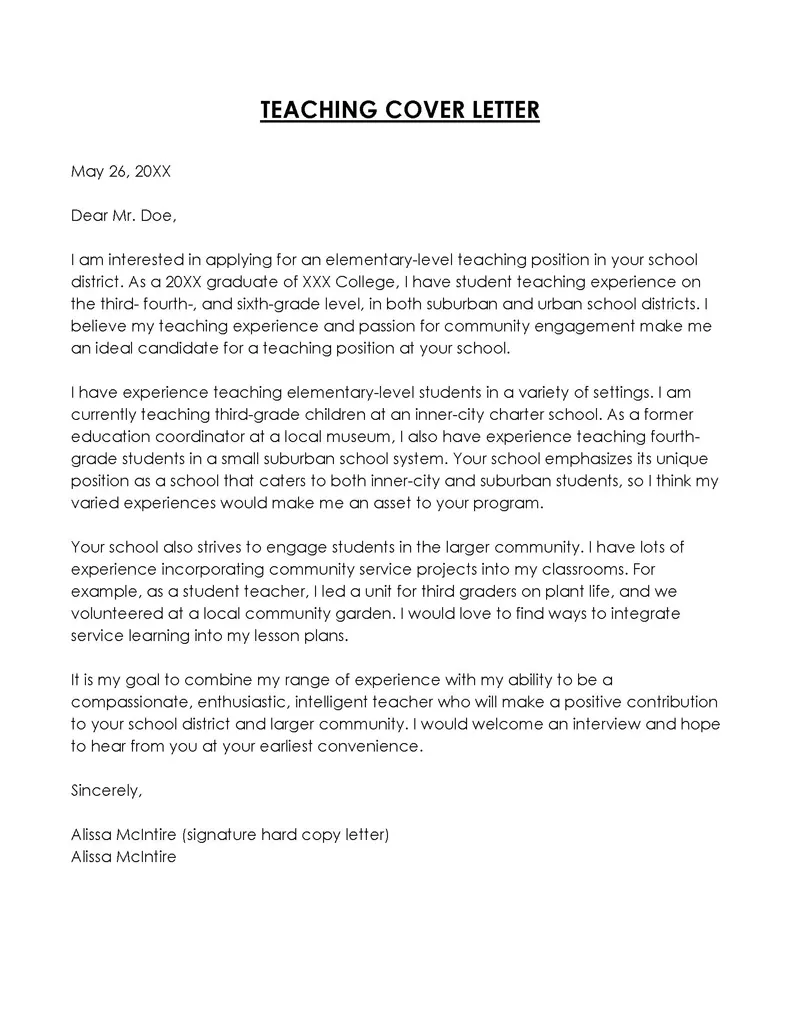
Before writing your cover letter, research the school’s mission, values, and any recent initiatives or programs. Visit the school’s website, read its mission statement, and review any information about its educational philosophy or priorities. Identify the school’s specific needs and challenges. Mention any awards, recognitions, or special programs the school has received. You should also look for information on the school’s demographics, student population, and community involvement. This research will allow you to demonstrate your knowledge and tailor your cover letter to align with the school’s specific needs and goals. Your homework on the school shows you care.
Addressing Specific Needs
Carefully review the job description and identify the specific needs and requirements of the position. Address each of these needs directly in your cover letter, providing examples of how your skills and experience align with those needs. If the school is seeking someone with experience in a particular subject or with a specific student population (e.g., students with special needs, English language learners), highlight your relevant experience. If the school is implementing a new program or initiative, explain how you can contribute to its success. Tailoring your response to specific criteria is very important.
Demonstrating How You Can Contribute
Clearly articulate how you can contribute to the school community. Explain how your skills, experience, and passion for teaching will benefit the students and the school. Mention any specific programs, initiatives, or activities you would be interested in contributing to. Show your understanding of the school’s goals and demonstrate how you can help the school achieve them. Offer to provide a sample lesson plan, portfolio, or any other materials that can showcase your teaching abilities. Highlight how your work can align with the goals of the school to stand out.
Formatting and Structure
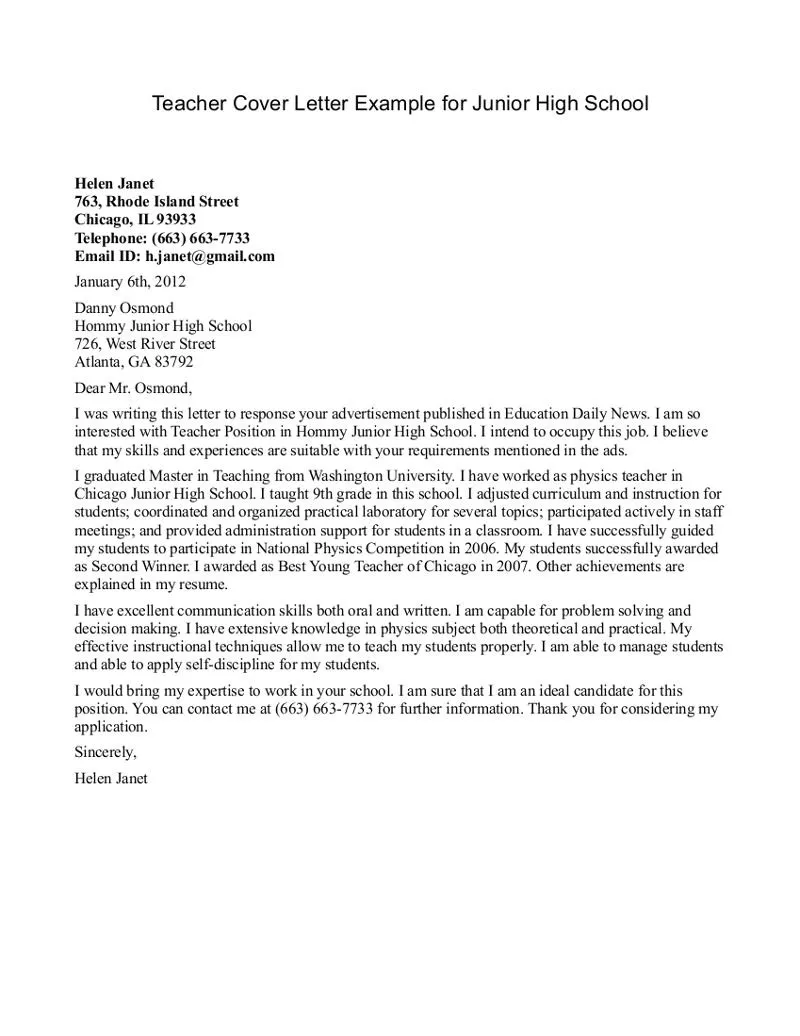
A well-formatted cover letter is easy to read and demonstrates your attention to detail. Pay close attention to the layout, font, and overall appearance of your letter. A professional and organized cover letter conveys that you take your application seriously. You must always aim for readability. Keep your content clear and concise.
Proper Salutation and Closing
Begin your cover letter with a professional salutation. If possible, address the hiring manager by name. If you can’t find a name, use a general salutation like “Dear Hiring Committee.” Use a formal closing such as “Sincerely” or “Respectfully,” followed by your name and contact information. Make sure you spell the names correctly. This should be one of the easiest aspects of writing a cover letter. Don’t overlook this. These small details can matter.
Concise and Engaging Content
Keep your cover letter concise and focused, aiming for one page. Use clear and concise language, and avoid jargon. Divide your letter into paragraphs to make it easier to read. Use strong action verbs to describe your accomplishments and experiences. Focus on the most relevant information and avoid repeating information that’s already in your resume. Your objective is to make it easy for the reader to understand who you are. Your cover letter should show you have excellent communication skills. A good structure is important.
Proofreading and Editing
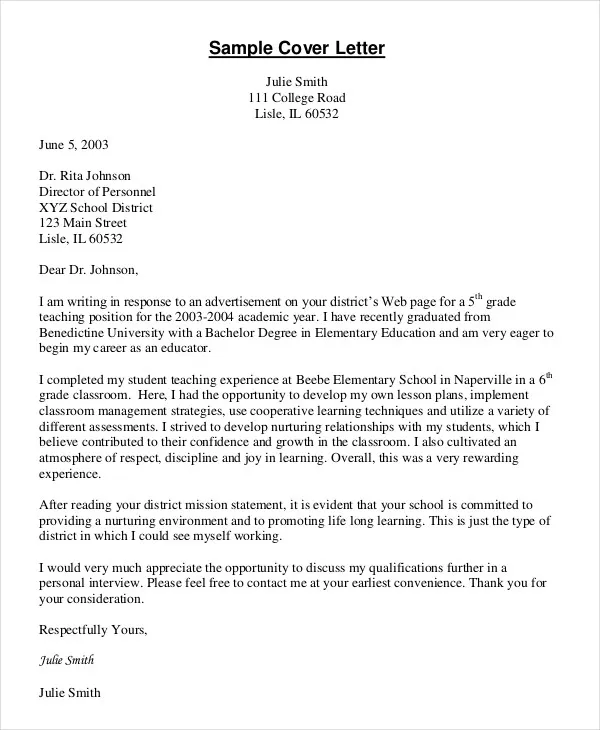
Proofread your cover letter carefully for any grammatical errors, spelling mistakes, or typos. Have a friend or colleague review your letter as well. Minor errors can undermine your credibility. A polished, error-free cover letter demonstrates your attention to detail. Ensure your writing is grammatically correct and your spelling is impeccable. Print out your cover letter and read it aloud to catch any awkward phrasing or inconsistencies. Consider using grammar and spell-checking software to catch any mistakes. Always make a good impression. Proofreading is non-negotiable.
The Importance of a Strong Introduction and Conclusion
The introduction and conclusion are the bookends of your cover letter, and they play a vital role in shaping the reader’s impression of you. A strong introduction grabs the reader’s attention and sets the tone for the rest of the letter. The conclusion reinforces your key points and expresses your enthusiasm for the position. The introduction is meant to be a hook, and the conclusion is meant to encourage an action.
Making a Great First Impression
Start your cover letter with a compelling introduction that grabs the reader’s attention. State the position you’re applying for and how you learned about the opportunity. Briefly mention your most relevant qualifications or experiences. Express your enthusiasm for the position and the school. Avoid generic opening lines and instead, try to personalize your introduction to the specific school or position. If you were referred by someone, mention the name here. The opening of your letter must be engaging.
Summarizing Your Strengths and Expressing Enthusiasm
In your conclusion, summarize your key strengths and reiterate your interest in the position. Reiterate how your skills and experience align with the school’s needs and goals. Thank the hiring manager for their time and consideration. Express your enthusiasm for the opportunity and your eagerness to learn more. End with a call to action, such as inviting them to contact you for an interview. A strong conclusion reinforces your key points and leaves the reader with a positive impression. The conclusion should reinforce the positive aspects of you and your potential contribution.
